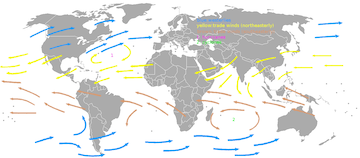trade winds.png

The yellow and brown lines on the map represent the different directions the trade winds blow. Photo Credit: Public Domain
Today, the word “trade” means to swap something. That hasn’t always been the case, though. Centuries ago, it meant a path or a track. The new definition blew in on the wind -- the trade wind.
Trade winds blow in belts that flank the equator. The Sun heats the air and oceans at the equator. Warm, humid air then rises and heads toward the poles. As it reaches about 30 degrees north and south of the equator, the air cools and descends.
Earth’s rotation deflects this flow. So as it reaches the surface, the air moves to the west and back toward the equator. That creates the most consistent, steady winds on the planet -- the trades.
Most of the time, trade winds blow at around 10 miles per hour. Sometimes, though, they can top 30 miles per hour. And they’re much more common over water than over land -- they seldom stop.
And that’s what led to their name. Early European sailors found that these bands of wind made their journeys across the Atlantic Ocean much faster. So, they were the right “path” to follow to the Americas. Since the ships carried goods, the name of the winds came to apply to the practice of swapping things -- of trading.
Changes in the trades in the Pacific Ocean can have a big impact on global weather. When they slow down, water in the eastern Pacific gets warmer, creating El Niño. And when they speed up, the water gets cooler, creating La Niña. These changes cause big shifts in climate in the U.S. and elsewhere -- “trading” weather patterns at the whim of the winds.

